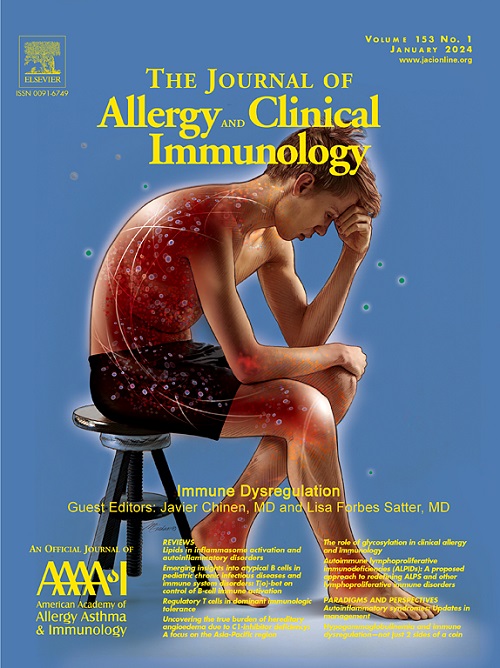Mesenchymal stem cell-derived small extracellular vesicles restored nasal barrier function in allergic rhinitis via miR-143–GSK3B in human nasal epithelial cells
IF 11.4
1区 医学
Q1 ALLERGY
引用次数: 0
Abstract
Background
The nasal epithelial barrier is the first line of defense against the deep entry of pathogens or aeroallergens and is more critical in allergic rhinitis (AR). Restoring epithelial barrier dysfunction might be a promising strategy for AR. Recent studies reported that mesenchymal stem cell–derived small extracellular vesicles (MSC-sEV) potentially inhibit the inflammation response and promote tissue regeneration. However, their effect on nasal epithelial cells remains unknown.
Objectives
This study sought to describe the therapeutic effect of MSC-sEV on AR, particularly focusing their effect on nasal epithelial cells and underlying molecular mechanisms.
Methods
We utilized an ovalbumin-induced mouse model to study AR. Both primary and immortalized human nasal epithelial cells (HNEpC) were used to further validate the therapeutic effects of MSC-sEV on epithelial cell function. Then we constructed microRNA (miR)-143 overexpressing and low-expressing HNEpC and MSC-sEV to elucidate molecular mechanisms. Transcriptome analysis was performed to identify the downstream pathways involved.
Results
MSC-sEV successfully maintained nasal barrier integrity in AR mouse model. The MSC-sEV therapeutic effect on the nasal barrier was substantiated in HNEpC. Mechanistically, miR-143 was a candidate mediator of the above effects. Subsequently, transfecting HNEpC with miR-143 partially mimicked the restoring effect of MSC-sEV. MSC-sEV overexpressing miR-143 exerted more therapeutic effects on tight junctions and barrier integrity. Moreover, miR-143 regulated the glycogen synthase kinase-3β (GSK3B) pathway.
Conclusions
Our results indicated that MSC-sEV mitigated AR and restored nasal epithelial barrier dysfunction through the miR-143–GSK3B axis, which suggested that MSC-sEV have the remarkable ability to treat AR.

间充质干细胞衍生的细胞外小泡通过人鼻上皮细胞中的miR-143-GSK3β恢复过敏性鼻炎的鼻屏障功能
背景:鼻腔上皮屏障是防止病原体或空气过敏原深入鼻腔的第一道防线,在过敏性鼻炎(AR)中更为关键。恢复上皮屏障功能障碍可能是治疗过敏性鼻炎的一种有前途的策略。最近的研究报告称,间充质干细胞(MSC)衍生的小细胞外囊泡(MSC-sEV)可抑制炎症反应并促进组织再生。然而,它们对鼻上皮细胞的影响仍然未知:本研究试图描述间充质干细胞-sEV 对 AR 的治疗效果,尤其是其对鼻上皮细胞的影响及其潜在的分子机制:我们利用卵清蛋白(OVA)诱导的小鼠模型来研究 AR。方法:我们利用卵清蛋白(OVA)诱导的小鼠模型研究 AR,并使用原代和永生化的人鼻上皮细胞进一步验证间充质干细胞-SEV 对上皮细胞功能的治疗作用。然后,我们构建了过表达和低表达 miR-143 的 HNEpC 和 MSC-sEV,以阐明分子机制。结果显示,MSC-sEV成功地维持了鼻腔上皮细胞的功能:结果:MSC-sEV成功地维持了AR小鼠模型鼻腔屏障的完整性。MSC-sEV对HNEpC鼻屏障的治疗效果得到证实。从机理上讲,microRNA(miR)-143 是上述作用的候选介导因子。随后,用miR-143转染HNEpC部分模拟了MSC-sEV的修复作用。过表达 miR-143 的 MSC-sEV 对紧密连接和屏障完整性有更多的治疗作用。此外,miR-143 还能调节 GSK3β 通路:我们的研究结果表明,间充质干细胞-SEV能通过miR-143-GSK3β轴缓解AR并恢复鼻上皮屏障功能障碍,这表明间充质干细胞-SEV具有治疗AR的显著能力。
本文章由计算机程序翻译,如有差异,请以英文原文为准。
求助全文
约1分钟内获得全文
求助全文
来源期刊
CiteScore
25.90
自引率
7.70%
发文量
1302
审稿时长
38 days
期刊介绍:
The Journal of Allergy and Clinical Immunology is a prestigious publication that features groundbreaking research in the fields of Allergy, Asthma, and Immunology. This influential journal publishes high-impact research papers that explore various topics, including asthma, food allergy, allergic rhinitis, atopic dermatitis, primary immune deficiencies, occupational and environmental allergy, and other allergic and immunologic diseases. The articles not only report on clinical trials and mechanistic studies but also provide insights into novel therapies, underlying mechanisms, and important discoveries that contribute to our understanding of these diseases. By sharing this valuable information, the journal aims to enhance the diagnosis and management of patients in the future.

 求助内容:
求助内容: 应助结果提醒方式:
应助结果提醒方式:


